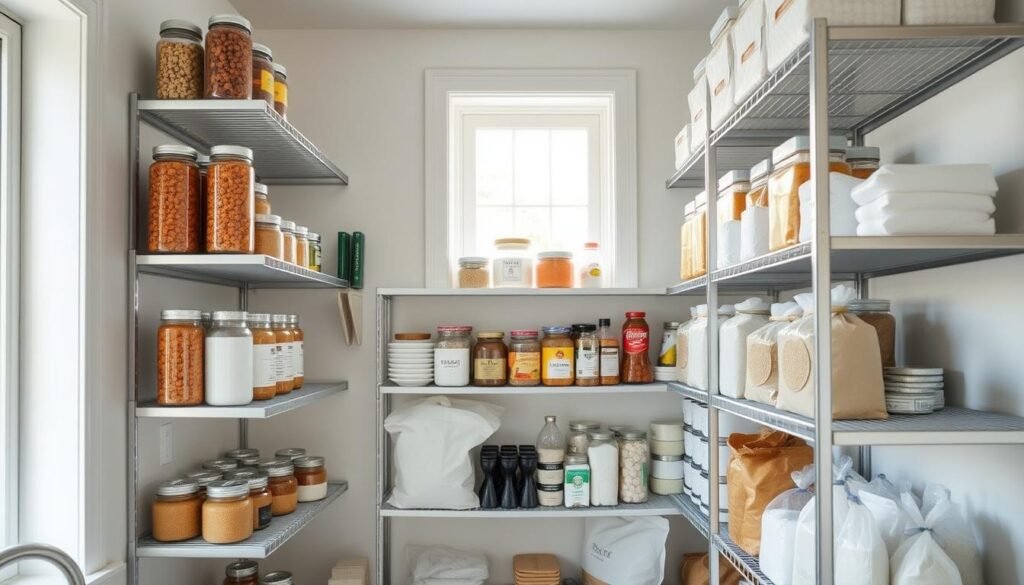
Did you know that a cluttered pantry can lead to wasted time and money? You’re not alone in the struggle to keep your kitchen organized!
Imagine being able to find the ingredients you need in seconds, without digging through cluttered shelves. Efficient pantry storage can transform your kitchen experience from frustrating to functional.
A well-organized pantry is more than just aesthetically pleasing – it’s about saving time, reducing food waste, and making meal preparation a breeze. By implementing a few simple changes, you can maximize your kitchen’s space and make cooking a joy.
Key Takeaways
- Discover the benefits of a well-organized pantry
- Learn how to assess your current pantry space
- Implement practical solutions for your kitchen layout
- Maximize your kitchen’s storage capacity
- Simplify your cooking routine with efficient organization
The Challenges of Pantry Organization
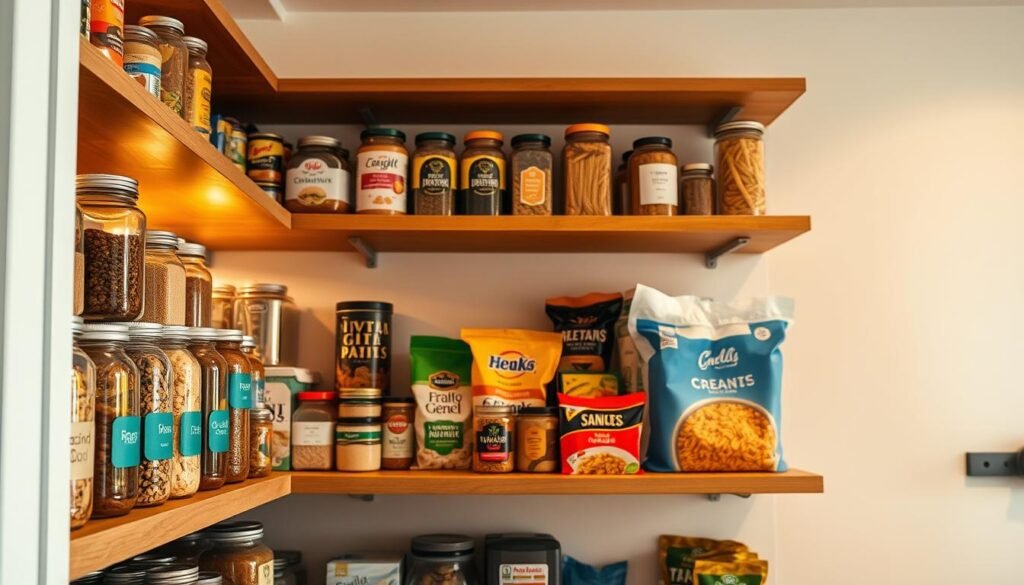
Have you ever found yourself wondering how your pantry went from organized to chaotic in just a few days? You’re not alone. Maintaining a tidy pantry is a challenge many of us face, especially after a grocery shopping spree.
Common Pantry Problems
Several issues contribute to pantry disorganization. Stacked cans can create unstable towers that are prone to toppling over, while items mysteriously migrate to the back of deep shelves, never to be seen again. These problems are common even among the most organized homeowners.
- Cluttered pantry space making meal preparation stressful
- Difficulty in locating ingredients due to disorganization
- Wasted food from forgotten purchases
The Impact of Disorganization on Meal Preparation
A disorganized pantry directly impacts your meal preparation time, adding stress and frustration to what should be an enjoyable cooking experience. When you’re searching for ingredients in a cluttered pantry space, even simple meals can take twice as long to prepare.
| Pantry Organization Challenges | Impact on Meal Preparation |
|---|---|
| Cluttered Space | Increased meal preparation time |
| Hidden or Forgotten Items | Wasted food and unnecessary purchases |
| Disorganized Storage | Added stress and frustration during cooking |
By understanding these challenges, you can begin to address the root causes of your pantry’s disorganization and take steps towards a more efficient and enjoyable kitchen experience.
Assessing Your Pantry Space
The journey to a well-organized pantry begins with evaluating your existing space and storage challenges. To create an effective pantry organization system, you first need to understand the layout and limitations of your pantry space.
This involves more than just glancing inside; it requires a thorough assessment of what’s working and what’s not. Consider the type of pantry you have—is it a deep cabinet with fixed shelves or a walk-in space with adjustable shelving?
Evaluating Your Current Storage Situation
Take a critical look at your pantry storage situation. Ask yourself: What’s working? What’s causing frustration? Identify areas that become disorganized most quickly.
Identifying Problem Areas and Opportunities
Learn to identify your pantry’s “problem zones”—those spots where items get lost, forgotten, or are difficult to access. By mapping your pantry space and measuring shelves, doors, and available wall areas, you can discover opportunities for improvement.
Understanding how your family’s cooking habits and grocery shopping patterns should influence your pantry organization strategy is also crucial.
The Foundation of Efficient Pantry Storage
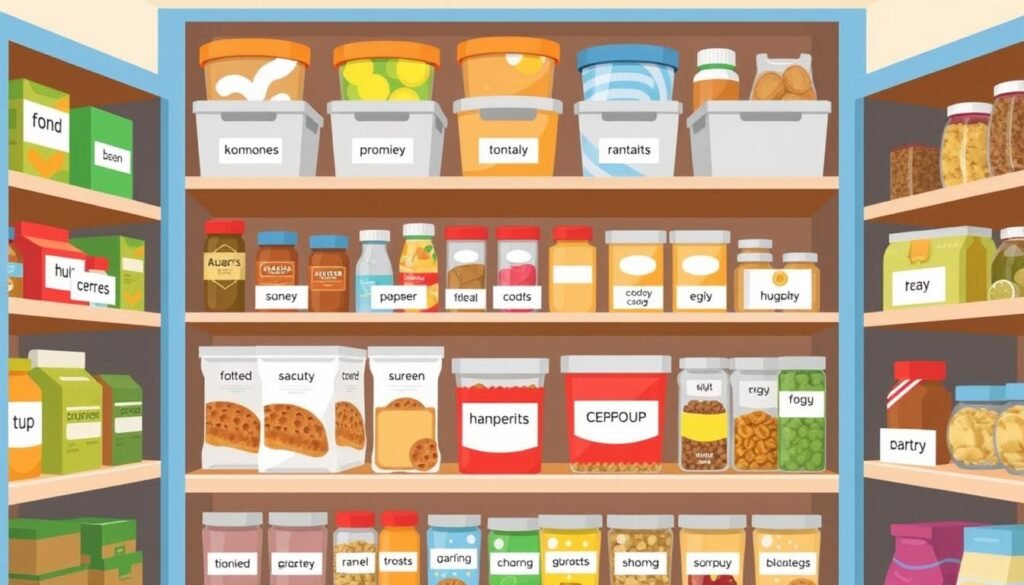
To maximize your pantry space, you need to lay the groundwork with a solid organization plan. This involves understanding your cooking habits, the items you use most, and how you can create a system that is both functional and sustainable.
Decluttering and Taking Inventory
Decluttering is the essential first step to efficient pantry storage. It involves ruthlessly assessing what deserves space in your pantry. Start by taking a complete inventory of your pantry items—checking expiration dates, identifying duplicates, and understanding what you actually use. This process helps you understand what you have and what you can discard or donate.
Creating Functional Zones and Categories
Creating categories will help you utilize your pantry space better and create a functional layout that meets your cooking habits. By prioritizing frequently used items, you can ensure that your pantry organization system is sustainable. Grouping similar items together not only saves time but also helps maintain order. You can organize your pantry items by meal type or group them by ingredient category to create a system that works best for you.
Smart Container Solutions

Organizing your pantry with smart container solutions is a game-changer for kitchen efficiency. The right storage containers can help you declutter, categorize, and access your pantry items with ease. By choosing the appropriate containers, you can create a system that makes meal preparation smoother and reduces food waste.
Clear Containers: When and What to Decant
Decanting pantry staples into clear containers can be a highly effective way to maintain visibility and inventory of your supplies. Consider transferring cereal, rice, pasta, quinoa, couscous, and oatmeal into clear bins to keep your pantry organized and make the most of your storage space. This approach helps you avoid duplicate purchases and ensures that older items are consumed before they expire.
Selecting the Right Bins and Baskets
When it comes to selecting the right bins and baskets for your pantry, consider the size, accessibility, and visibility needs of different zones. For instance, use airtight jars for storing snacks and small items, and larger storage containers for bulk supplies. Labeling your containers is also crucial for maintaining an organized pantry; simple label makers or handwritten labels can work wonders.
Maximizing Vertical Space
Maximizing your pantry’s storage capacity often starts with a simple yet effective strategy: utilizing vertical space. Think about it – when was the last time you looked up and considered the potential storage area above your pantry shelves? By making the most of this often-wasted space, you can significantly increase your pantry’s storage capacity without needing any major renovations.
Shelf Risers and Tiered Organizers
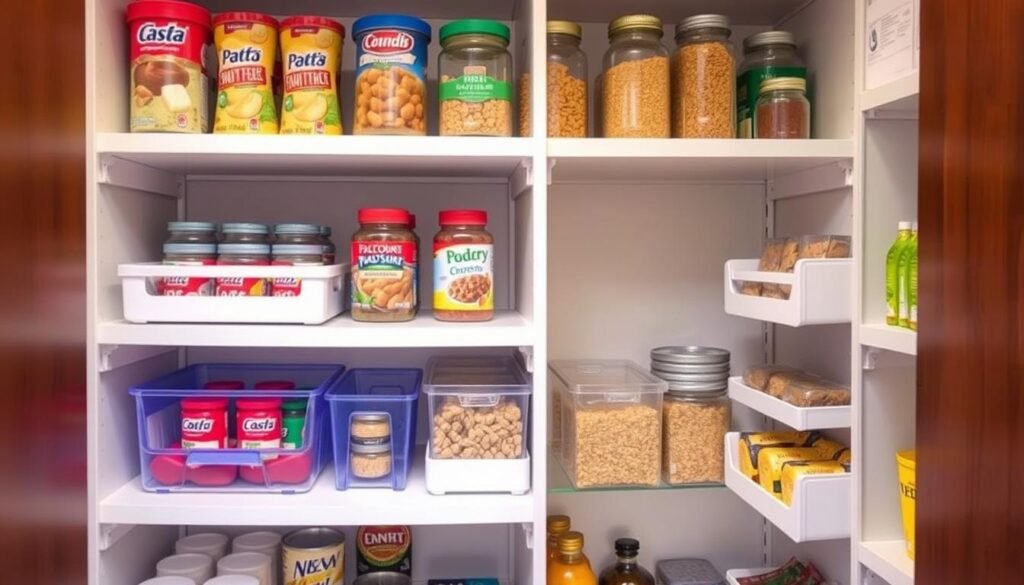
Shelf risers and tiered organizers are game-changers for pantry storage. They allow you to stack items like spices, dry goods, and jars more efficiently, effectively doubling your storage space. For instance, if you have a shelf that’s a foot tall but you’re only using half of it, a shelf riser can help you utilize that wasted space above your jars or containers.
Utilizing Wall and Door Space
Don’t forget about the walls and doors of your pantry! Over-the-door organizers, hanging systems, and wall-mounted racks can transform these areas into functional storage spaces. You can store items like snacks, cleaning supplies, or even cooking utensils, keeping them accessible yet out of the way.
By implementing these strategies, you’ll not only maximize your pantry’s vertical space but also create a more organized, efficient kitchen environment.
Solutions for Deep Pantry Shelves
Are you tired of rummaging through deep pantry shelves only to find expired or lost items? You’re not alone. Deep pantry shelves can be a significant challenge when it comes to maintaining an organized kitchen. However, there are effective solutions to make the most of this space.
Pull-Out Drawers and Sliding Organizers
One transformative solution for deep pantry shelves is the use of pull-out drawers and sliding organizers. By installing these, you can access everything stored inside without having to reach into the “dark abyss” of the deep shelves. For instance, purchasing pull-out drawers that fit your pantry shelves’ dimensions can revolutionize your storage. With just a gentle pull, everything is in view.
Turntables and Lazy Susans for Corner Access
Another practical solution is utilizing turntables and lazy Susans, especially for corner spaces in your pantry storage. These tools allow you to easily access items stored in the back without having to maneuver awkwardly or remove everything in front. By making the most of your corner spaces, you can significantly enhance your pantry’s overall storage capacity.
To implement these solutions effectively, consider measuring your pantry shelves to select the right size and type of organizers. Whether you opt for DIY options or professional installations, there are various types of pull-out systems available to fit different budgets and skill levels.
Specialized Storage for Common Items
A clutter-free pantry is within reach when you implement specialized storage solutions tailored to your most frequently used items. Certain pantry staples, like spices, canned goods, and snacks, require unique storage approaches to maximize efficiency and accessibility.
Spice Organization Systems
Spice organization can transform your cooking experience. Consider using drawer inserts or door-mounted racks to keep your spices visible and within reach. These systems help you quickly identify the spice you need, saving time during meal preparation.
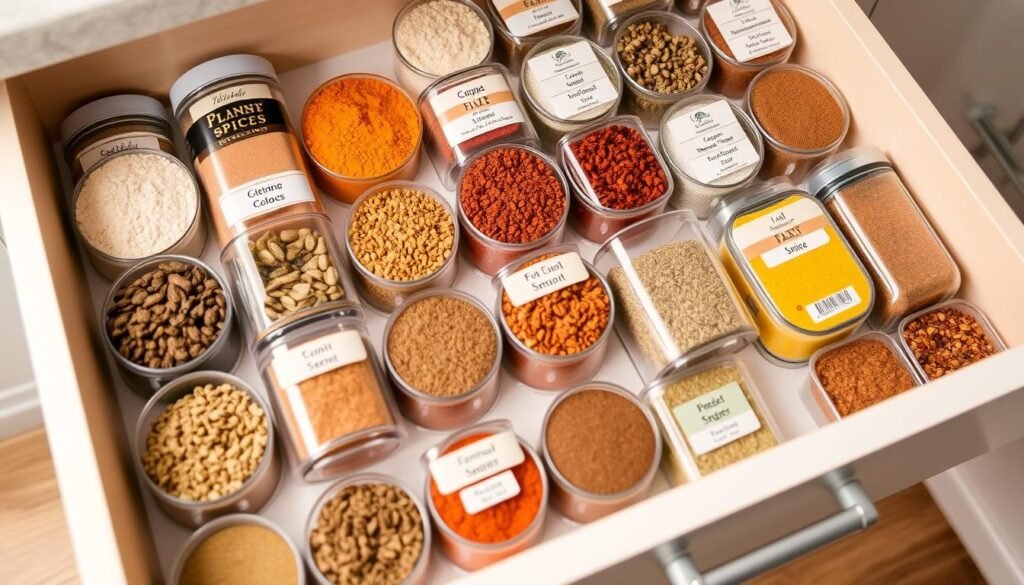
Canned Goods Storage Solutions
For canned goods, try using a rack that stores cans on their sides. This allows for easy access and visibility, much like the satisfaction of removing one can and having the next slide into place. Such racks are designed to maximize storage while minimizing clutter.
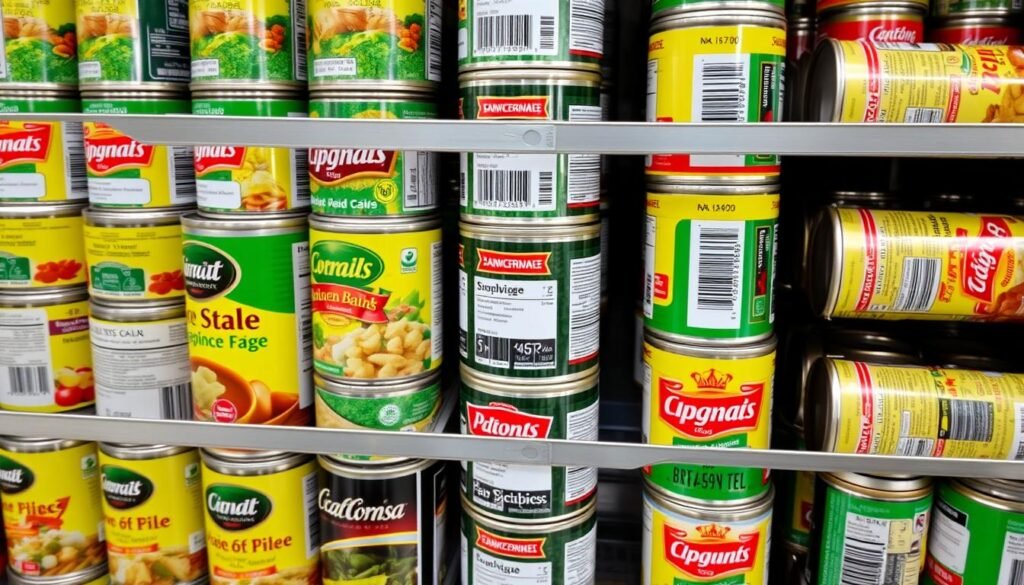
Snack and Small Item Management
Items like apple sauce pouches, bags of snacks, and peanut butter packets can be stored harmoniously in stackable bins. Open-front bins make it easier to keep an inventory of small snacks and loose items, ensuring they’re easily accessible for the whole family.
Maintaining Your Organized Pantry
Maintaining an organized pantry is a journey, not a destination. You’ve worked hard to get your pantry organized, but keeping it that way requires some effort. The truth is, many pantry organization systems fail within weeks because they don’t account for the changing needs of the household.
To keep your pantry organization system functioning smoothly, develop simple daily and weekly habits. For example, take a few minutes each day to tidy up and put away items after meal prep. Weekly, check expiration dates and wipe down shelves.
As your family’s needs and cooking habits change, your pantry storage system should adapt. Be prepared to reassess and make incremental improvements rather than overhauling the entire system. The goal is to strike a balance between maintaining order and embracing flexibility.
It’s also important to remember that “pantry perfection” is overrated. What’s more important is creating a pantry organization system that prioritizes function over aesthetics. Your pantry should work for you, not the other way around. By focusing on functionality and making adjustments as needed, you’ll be able to maintain your organized pantry for the long term.
FAQ
How do I start organizing my kitchen cabinets?
Begin by taking everything out and sorting items into categories. Then, assess what you have, get rid of expired or unused items, and assign a home for each category using containers and shelves.
What are the best containers for dry goods like rice and pasta?
Look for airtight, clear containers that are the right size for your needs. Glass or plastic jars with lids are great options, as they keep food fresh and are easy to label.
How can I maximize space on deep shelves?
Use pull-out drawers or sliding organizers to make the most of deep shelves. You can also use turntables or Lazy Susans to access items in the back.
What’s the best way to organize spices?
Use a spice organization system that fits your needs, such as a spice rack or a drawer organizer. You can also label your spices to ensure you can find what you need quickly.
How can I keep my snacks and small items organized?
Use baskets or bins to corral small items like snacks, nuts, or dried fruit. You can also use small containers or jars to keep items like coffee or tea fresh.
How often should I maintain my organized pantry?
Schedule regular tidying sessions, ideally every few months, to maintain your organized pantry. Go through your shelves and containers, and make sure everything is still in its assigned home.
